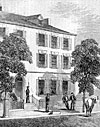Several times a day, President Lincoln visited the War Department to get the latest news of the war. Of all the places associated with the war effort, the telegraph office was his most frequent destination. It was a secure site and Mr. Lincoln could enjoy a moment’s peace – if the war news was good. One morning, he went to the telegraph office with Secretary of State Seward and inquired if there was any news. “Good news, because none,” a telegraph operator told the President. “Ah, my young friend, that rule does not always hold good, for a fisherman does not consider it good luck when he can’t get a bite.”1
For much of the war, the Union had trouble getting a bite out of the Confederacy. Jealousy and dissension among the generals of the Army of the Potomac was a particular problem. But gradually, the President assembled a team of army and navy officials who understood his conception of the war and implemented his policies. They tolerated his habit for preferring civilian mercy to military justice and supported his reelection over Democrat George B. McClellan in 1864.
Before Secretary of War Edwin M.Stanton took office in January 1862, the real headquarters of the Union effort was the office of General George B. McClellan. President Lincoln often visited McClellan’s headquarters and occasionally was snubbed by the insolent general. Mr. Lincoln never retaliated against such behavior but he did shift most future meetings to the White House or War Department. He also visited McClellan at the war front – as President Lincoln did other commanders of the Army of the Potomac.
Mr. Lincoln did not consider himself a particularly courageous man and sometimes marveled that he was expected to instill confidence in his military subordinates. But when Confederate General Jubal Early threatened Washington on July 10-12, 1864, Mr. Lincoln did not hesitate. On two successive days, July 11 and July 12, President Lincoln visited embattled Fort Stevens. One Ohio soldier later recalled: “Lincoln got to the fort ahead of us. He was quiet and grave. He mounted the parapet so he could see better, and I saw him there in full view of the ‘Johnnies,’ watching them and what went on inside. You can imagine what a target he made with tall form and stovepipe hat.”2
By July 12, the VI Corps under General Horatio Wright had arrived in Washington from the Richmond front, relieving the convalescent and volunteer troops who had mobilized to defend the city. General Early refrained from an all-out attack and the capital was saved. Firing on Fort Stevens continued, however.
The President ignored the entreaties of General Wright that he remove himself from the view of Confederate sharpshooters. Instead, Mr. Lincoln held his ground. He returned the next day and took a similar position. This time, a colonel implored him to get down: “Please down to a safe place. If you do not, it will be my duty to call a file of men and make you.” Responded the President: “And you would be quite right, my boy. You are in command of this fort. I should be the last man to set an example of disobedience.”3
Footnotes
- David Homer Bates, Lincoln in the Telegraph Office, p. 200.
- John H. Cramer, Lincoln Under Enemy Fire, p. 46.
- Cramer, Lincoln Under Fire, p. 51.














